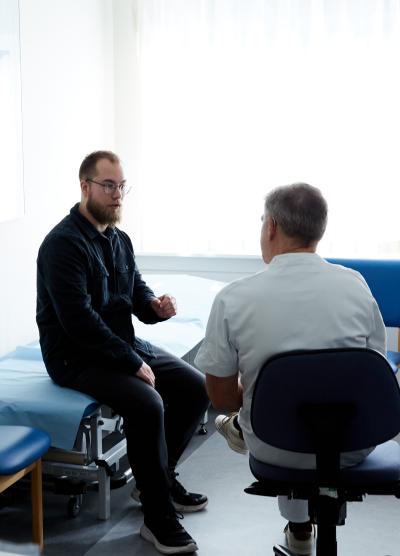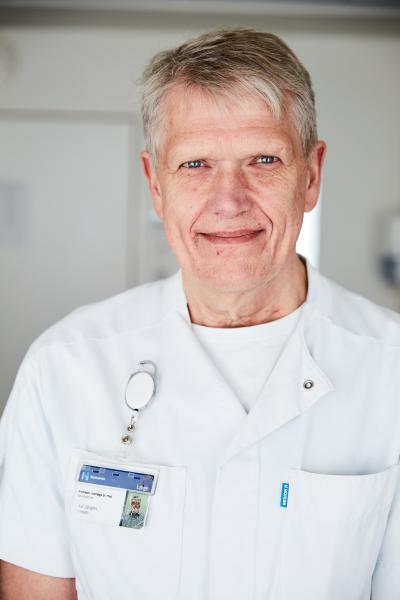Newly discovered molecule may have the key to sleep’s control room
Danish researchers dream of finding a ‘dial’ to regulate the urge to sleep. A newly discovered molecule may hold the key. In the long term, it could help narcolepsy patients like Isak Jørgensen, whose condition makes them fall asleep suddenly and involuntarily.
I tried to plan breaks so I could take a nap between classes. But it didn’t help. I kept dropping off mid-lesson
His eyes fell shut, even though it was mid-morning. As a 17-year-old high-school student, Isak Jørgensen just couldn’t stay awake – and not because the history lesson was boring or he’d spent all night partying or gaming. Isak was studious and hard-working but looked like a bit of a zombie.
He didn’t just doze off in the mornings. It would happen at lunchtime, in the afternoon, at pretty much any time of day – no matter how early he went to bed the night before.
‘At first, I just thought, “Wow, I’m knackered. More coffee!” I tried to plan breaks so I could take a nap between classes. But it didn’t help. I kept dropping off mid-lesson,’ says Isak, who is now 28.
Asleep on the dance floor
‘What Isak didn’t know was that he had narcolepsy – an incurable sleep disorder that makes you fall asleep suddenly and uncontrollably, no matter how well rested you ought to be,’ explains Poul Jennum, clinical professor and chief physician at the Danish Center for Sleep Medicine at Rigshospitalet.
‘It’s a chronic neurological disorder that makes you fall asleep – anywhere, anytime – at the football, at the dancing, in school. Patients lose control over wakefulness and have what we call cataplexy attacks – a sudden onset of muscle weakness,’ Jennum explains.

The professor has been researching narcolepsy for over two decades and is one of the pioneers in the mapping and treatment of the condition, which has long baffled scientists. It is difficult to understand the causes, difficult to diagnose and very difficult to treat.
‘It may sound a bit trivial, almost funny, but it really isn’t. It’s considered socially unacceptable not to be able to stay awake. It’s a socially inhibiting condition, so many of the patients end up opting out of large parts of ordinary life because they find it embarrassing to fall asleep in the middle of things,’ Jennum continues.
‘Because it used to be difficult to diagnose, a lot of patients weren’t taken seriously. And they are often misdiagnosed – or not diagnosed at all. Indeed, they were often branded as slackers and lazy right up until the 1990s, and rather than receiving treatment, they would just be told to get their act together,’ he adds.
Good-natured banter
Isak was frequently the subject of good-natured banter because nobody knew he was ill – not him, his friends, his teachers.
‘I was the butt of a lot of jokes and smart comments. It wasn’t malicious, but some people clearly thought I was a bit lazy and that I should make more of an effort to stay awake. I found it difficult to keep up, which was massively frustrating because I really did want to study,’ he says. His undiagnosed condition caused other problems, too.
‘I dreamt a lot when I dozed off. Sometimes it was a strange mixture of sleeping and being awake. I’d be in class, listening to the teacher, and suddenly his phone would ring. He’d answer it, which I thought was a strange thing to do in the middle of a lesson. Then I woke up and realised he hadn’t been on the phone at all.’
Unfortunately for Isak, his condition deteriorated, which had major consequences for his education.
Patients ill-served until the late ’90s
It was not until the late 1990s that a breakthrough was made in narcolepsy research.
In Norway, researchers looking at the part of the brain called the hypothalamus found a hormone that they thought might affect sleep. Then in 1998, two teams of researchers in the USA and Japan discovered a neurotransmitter called hypocretin or orexin, which influences whether you are awake or sleepy. More hypocretin, more awake, less hypocretin, more tired.
This piqued Poul Jennum’s interest. Along with a group of scientists at Stanford University and with support from the Lundbeck Foundation, he has since been involved in several projects focusing on the condition.
‘Previously, narcolepsy patients were often ill-served and had little hope of effective treatment. But we successfully identified hypocretin in the cerebrospinal fluid. We took fluid from the spinal cord and examined the hypocretin content. Like our Stanford colleagues, we could see that the narcolepsy patients have a significantly lower proportion of the hormone,’ Jennum says.

The method is now used internationally to diagnose patients with 99–100% certainty. Along with neurologist Stine Knudsen and biologist Birgitte Kornum, Professor Jennum went on to study several of the mechanisms behind narcolepsy.
It turns out that the condition is an autoimmune disorder that causes the body to react against the brain’s hypocretin cells, destroying their ability to produce the hormone.
Hallucinations and nightmares
For Isak, the stage between being awake and asleep turned into an ongoing nightmare.
‘I’d be watching the teacher explain something, and then I’d look at the board and see it was covered in writing that I had to jot down as fast as possible. But when I looked up again, the board would be empty, and my notes were nothing but illegible doodles. It just escalated from there,’ he explains.
He did not know that he was suffering from what are known as hypnagogic hallucinations, which typically occur between wakefulness and sleep. It was not just annoying but had an adverse effect on his mental health and led him to see a doctor. He was referred first to a sleep clinic and later to the Danish Center for Sleep Medicine, where he was treated by Professor Jennum.
‘I found out that I had narcolepsy and that my hypocretin level was about 50% of what it should be. It was a bit of a blow to hear this but a bit of a relief, too. A blow because I had been diagnosed with something incurable, but a relief because I finally knew what was wrong with me. The hallucinations didn’t mean I was going insane,’ he says.
Nonetheless, the diagnosis did have consequences for Isak’s schooling.
‘I had to drop out of high school because I couldn’t keep up or do the homework. The system just wasn’t made for people like me,’ says Isak – but he didn’t give up on education.
Huge progress
In the 20-plus years since the first breakthroughs, huge progress has been made in the understanding and treatment of narcolepsy.
‘New treatments have been invented, we have significantly reduced symptoms, and the ability to diagnose and provide faster treatment has been a great help,’ Jennum says.
Before the treatment improved, only one-third of people with narcolepsy had jobs, and they earned only two-thirds of the average wage. People with the condition often have a limited social life, and some are quite traumatised. Better treatment and support have improved the situation.
Medication alone is not enough. Rigshospitalet also offers social counselling, psychological help, and guidance for schools and other educational establishments. However, as the professor points out, there’s still much more to do.
‘A lot of people out there still haven’t been diagnosed, and they need help,’ he says. ‘Before the treatment improved, only one-third of people with narcolepsy had jobs, and they earned only two-thirds of the average wage. People with the condition often have a limited social life, and some are quite traumatised. Better treatment and support have improved the situation.’
A long, hard process
Being treated at Rigshospitalet improved Isak’s quality of life.
‘It’s been a long, sometimes difficult process. The medicine I take helps me maintain a balance between sleeping and being awake. It’s not perfect, but it means I can do far more than before,’ he says.
The treatment has also helped him to take an HF exam, and he qualified as a web developer in January 2023.
‘Just after I dropped out of school, I didn’t know what to do. It was all too much. I had no idea whether I’d be able to cope with education at all. That made everything doubly difficult. It was bad enough not knowing what to do – but on top of that I just felt weak because I was sick,’ he says.
More and more new discoveries
Danish researchers are still making discoveries that may have long-term significance for the treatment of narcolepsy.

Last year, Associate Professor Birgitte Kornum, who is now at the University of Copenhagen, and Assistant Professor Anja Holm from Aalborg University, published a study supported by the Lundbeck Foundation that shows that a molecule called microRNA-137 (or miR-137) helps to regulate hypocretin levels. The hope is that miR-137 will act as what Kornum calls a ‘dial’.
‘It could mean that at some point in the future we will be able to dial hypocretin levels up and down. Up to help patients stay awake; down so they can sleep. That would bring us closer to treatments for conditions such as chronic fatigue, tiredness after chemotherapy, COVID-19, sleep apnoea and narcolepsy,’ says Kornum.
According to Professor Jennum, the discovery could also lead to better treatments for other brain disorders.
‘We know which substance is missing in the brains of narcolepsy patients, and we expect to be able to replace it with a drug at some point. These small pieces of the puzzle help us understand other conditions in which brain cells break down. The research methods are transferable to other disorders, such as Parkinson’s or dementia. If we make a little bit of progress in this area, we can do it in others, too,’ he says.
Indescribably brilliant
Despite his condition, Isak is in a much better place now – he is a new graduate, ready to start work.
‘I’m happy to be where I am today. I’m in a completely different place than when I had to drop out of high school. Back then, I was close to losing myself. I couldn’t tell the difference between up and down, between reality and nightmare,’ he recalls.
‘The dream is, of course, that the condition can be fixed completely. But I’m glad that the medication will let me hold down a job. It’s been almost unbearable, but I’m still standing. I may still face major challenges in life, but the improvement has been just indescribably brilliant.’